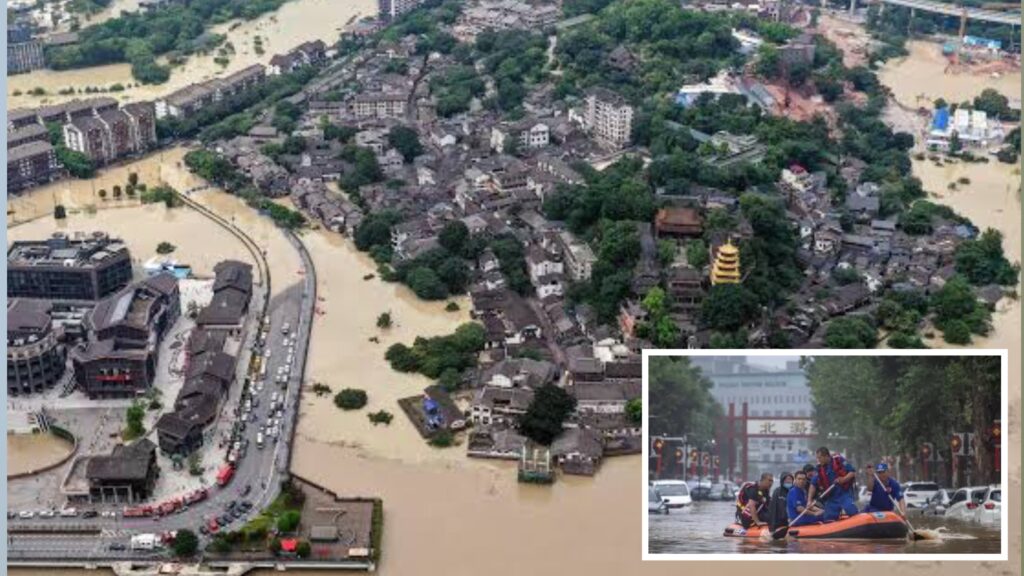In recent days, heavy rain causes floods in China, leaving behind severe damage to infrastructure and disrupting the lives of thousands.

The worst-hit regions include Guizhou Province, where overflowing rivers submerged streets, trapped vehicles, and forced residents to evacuate. While China often deals with seasonal rain, this year’s rainfall has been particularly intense, resulting in flooding across urban and rural areas alike.
Table of Contents
Rising Waters and Growing Concerns
As heavy rain causes floods in China, city streets turned into rivers and underground parking lots filled with water within minutes. In Rongjiang County, for instance, visuals showed parked cars almost fully submerged, with shops and homes quickly inundated. Emergency teams have been deployed to rescue people trapped in low-lying areas, while local authorities have issued the highest-level flood warnings in multiple districts.
Residents have expressed concern over the speed and force of the water, which left them with little time to move their belongings or seek shelter. Public transportation has been halted in some places, and schools have been temporarily shut down. The Chinese Meteorological Department reported that rainfall in several provinces has already surpassed monthly averages—despite the month not yet ending. As floodwater continues to spread, fears of landslides and further damage grow.
Despite such challenges, China’s rapid response teams, equipped with boats and drones, have managed to assist thousands. Shelters have been set up in schools and community centers, and basic supplies like food and drinking water are being distributed to those displaced.
A Silver Lining: Relief for Drought-Hit Areas
Interestingly, while heavy rain causes floods in China, not all its effects are negative. Many parts of the country had been facing a prolonged drought, especially in central and northern regions. The sudden influx of rainwater is expected to replenish dry reservoirs and boost groundwater levels. This may bring temporary relief to the agricultural sector, which has struggled with dry fields and declining crop yields in recent months.
In fact, several farmers in previously drought-affected regions have welcomed the rain. With improved water levels, irrigation systems can function more efficiently, and upcoming planting seasons may show better results. Experts believe that if the rainfall can be controlled or diverted effectively, it might support long-term agricultural stability.
Still, managing this balance remains a challenge. While drought relief is a positive outcome, the uncontrolled nature of flooding poses continued risk. The government has urged local authorities to monitor both dam safety and water storage carefully to avoid further disaster.
Preparing for More Rain Ahead
As meteorologists warn of more rain in the coming days, communities are being advised to stay alert. The forecast indicates that the current weather system could move eastward, potentially affecting cities like Shanghai and parts of Hunan and Jiangxi provinces. Emergency preparedness measures are being reinforced across high-risk zones.

Given that heavy rain causes floods in China nearly every monsoon season, discussions about long-term infrastructure upgrades are back in the spotlight. There is a growing push for better drainage systems, improved urban planning, and investment in weather prediction technology. These steps are seen as critical to minimizing damage in future flood events.
China has already experienced significant changes in rainfall patterns due to climate change. Experts note that as global temperatures rise, extreme weather events like flash floods and heatwaves will likely become more frequent and intense. In this context, the current floods serve as both a warning and a wake-up call.
Conclusion
The fact that heavy rain causes floods in China year after year highlights a pressing need for sustainable solutions. While the recent downpour has caused widespread damage, it also brings much-needed relief to areas suffering from water scarcity. Going forward, the key challenge will be managing these extremes—ensuring safety during floods while capturing water for future use.
As the skies continue to pour and rivers rise, the people of China once again show resilience in the face of nature’s force. With better planning, stronger systems, and community awareness, the country can hope to turn such disasters into opportunities for long-term resilience.
Do Follow for daily news.
